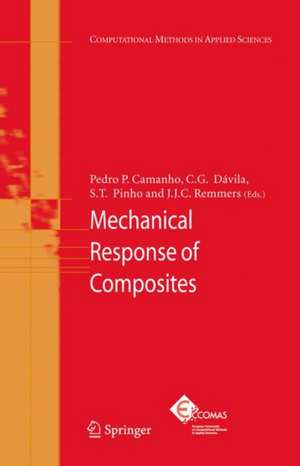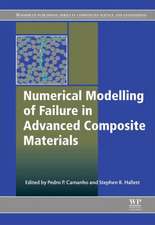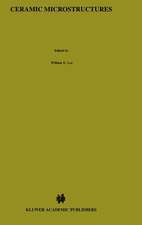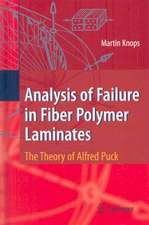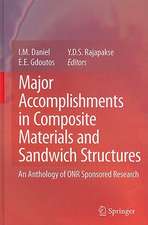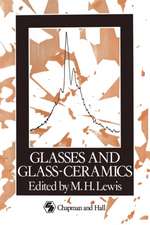Mechanical Response of Composites: Computational Methods in Applied Sciences, cartea 10
Editat de Pedro P. Camanho, C. G. Dávila, S. T. Pinho, J. J. C. Remmersen Limba Engleză Hardback – 21 iun 2008
| Toate formatele și edițiile | Preț | Express |
|---|---|---|
| Paperback (1) | 1218.53 lei 6-8 săpt. | |
| SPRINGER NETHERLANDS – 30 noi 2010 | 1218.53 lei 6-8 săpt. | |
| Hardback (1) | 1224.54 lei 6-8 săpt. | |
| SPRINGER NETHERLANDS – 21 iun 2008 | 1224.54 lei 6-8 săpt. |
Din seria Computational Methods in Applied Sciences
- 15%
 Preț: 655.27 lei
Preț: 655.27 lei - 15%
 Preț: 651.51 lei
Preț: 651.51 lei - 15%
 Preț: 657.73 lei
Preț: 657.73 lei - 5%
 Preț: 709.87 lei
Preț: 709.87 lei - 18%
 Preț: 1116.26 lei
Preț: 1116.26 lei - 18%
 Preț: 947.35 lei
Preț: 947.35 lei - 18%
 Preț: 952.89 lei
Preț: 952.89 lei - 18%
 Preț: 947.35 lei
Preț: 947.35 lei - 20%
 Preț: 653.38 lei
Preț: 653.38 lei - 18%
 Preț: 954.45 lei
Preț: 954.45 lei - 15%
 Preț: 638.76 lei
Preț: 638.76 lei - 18%
 Preț: 1005.74 lei
Preț: 1005.74 lei - 20%
 Preț: 648.59 lei
Preț: 648.59 lei - 18%
 Preț: 954.45 lei
Preț: 954.45 lei - 20%
 Preț: 640.19 lei
Preț: 640.19 lei - 18%
 Preț: 1231.16 lei
Preț: 1231.16 lei - 24%
 Preț: 789.37 lei
Preț: 789.37 lei - 18%
 Preț: 946.41 lei
Preț: 946.41 lei - 20%
 Preț: 567.63 lei
Preț: 567.63 lei - 15%
 Preț: 639.25 lei
Preț: 639.25 lei - 18%
 Preț: 952.57 lei
Preț: 952.57 lei - 15%
 Preț: 636.80 lei
Preț: 636.80 lei - 15%
 Preț: 650.69 lei
Preț: 650.69 lei - 18%
 Preț: 952.26 lei
Preț: 952.26 lei - 18%
 Preț: 1239.99 lei
Preț: 1239.99 lei - 5%
 Preț: 716.65 lei
Preț: 716.65 lei
Preț: 1224.54 lei
Preț vechi: 1493.34 lei
-18% Nou
Puncte Express: 1837
Preț estimativ în valută:
234.32€ • 250.56$ • 195.37£
234.32€ • 250.56$ • 195.37£
Carte tipărită la comandă
Livrare economică 18 aprilie-02 mai
Preluare comenzi: 021 569.72.76
Specificații
ISBN-13: 9781402085833
ISBN-10: 1402085834
Pagini: 332
Ilustrații: XVIII, 314 p.
Dimensiuni: 155 x 235 x 22 mm
Greutate: 0.64 kg
Ediția:2008
Editura: SPRINGER NETHERLANDS
Colecția Springer
Seria Computational Methods in Applied Sciences
Locul publicării:Dordrecht, Netherlands
ISBN-10: 1402085834
Pagini: 332
Ilustrații: XVIII, 314 p.
Dimensiuni: 155 x 235 x 22 mm
Greutate: 0.64 kg
Ediția:2008
Editura: SPRINGER NETHERLANDS
Colecția Springer
Seria Computational Methods in Applied Sciences
Locul publicării:Dordrecht, Netherlands
Public țintă
ResearchCuprins
Computational Methods for Debonding in Composites.- Material and Failure Models for Textile Composites.- Practical Challenges in Formulating Virtual Tests for Structural Composites.- Analytical and Numerical Investigation of the Length of the Cohesive Zone in Delaminated Composite Materials.- Combining Elastic Brittle Damage with Plasticity to Model the Non-linear behavior of Fiber Reinforced Laminates.- Study of Delamination in Composites by Using the Serial/Parallel Mixing Theory and a Damage Formulation.- Interaction Between Intraply and Interply Failure in Laminates.- A Numerical Material Model for Predicting the High Velocity Impact Behaviour of Polymer Composites.- Progressive Damage Modeling of Composite Materials Under Both Tensile and Compressive Loading Regimes.- Elastoplastic Modeling of Multi-phase Metal Matrix Composite with Void Growth Using the Transformation Field Analysis and Governing Parameter Method.- Prediction of Mechanical Properties of Composite Materials by Asymptotic Expansion Homogenisation.- On Buckling Optimization of a Wind Turbine Blade.- Computation of Effective Stiffness Properties for Textile-Reinforced Composites Using X-FEM.- Development of Domain Superposition Technique for the Modelling of Woven Fabric Composites.- Numerical Simulation of Fiber Orientation and Resulting Thermo-Elastic Behavior in Reinforced Thermo-Plastics.
Textul de pe ultima copertă
This book contains twelve selected papers presented at the ECCOMAS Thematic Conference — Mechanical Response of Composites, and the papers presented by the three plenary speakers.
It describes recent advances in the field of analysis models for the mechanical response of advanced composite materials, ranging from the simulation of the manufacturing process to the inelastic response and collapse of the material. The analysis models are based on recent advances in computational mechanics such as multi-scale modeling, cohesive and partition of unity models.
It describes recent advances in the field of analysis models for the mechanical response of advanced composite materials, ranging from the simulation of the manufacturing process to the inelastic response and collapse of the material. The analysis models are based on recent advances in computational mechanics such as multi-scale modeling, cohesive and partition of unity models.
Caracteristici
The use of advanced computational methods for the simulation of a broad range of physical processes in different types of advanced composite materials (unidirectional, woven and non-crimp fabrics, nanocomposites) The physical processes addressed include the manufacturing processes, the elastic and inelastic material response at several scales, and the structural collapse
